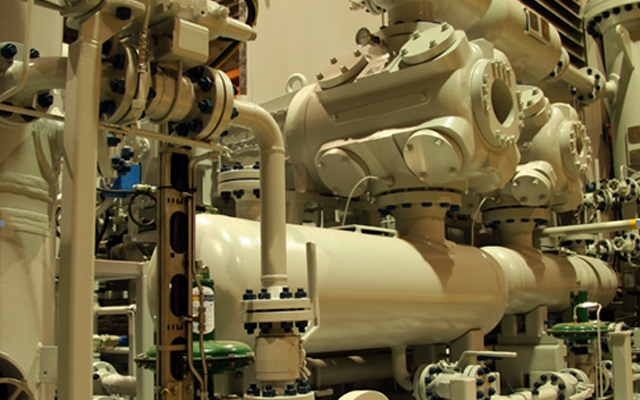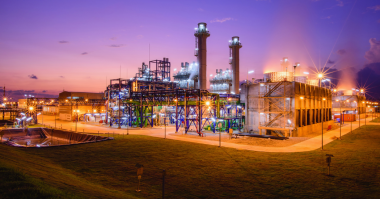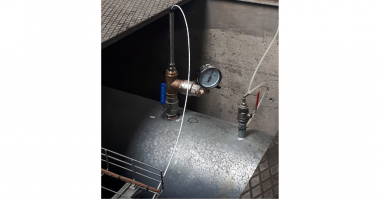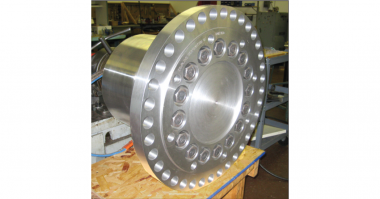The Role Compression Ratio Plays in Compressor Design and Selection
Author: Robert X. Perez, Machinery Engineer
One of the critical parameters in compressor design and selection is the compression ratio, often denoted as r, required for each stage of compression. The compression ratio is simply the ratio of the absolute stage discharge pressure to the absolute stage suction pressure. Because most gases increase in temperature when they are compressed, the final compressor outlet temperature is always a concern. A high discharge temperature can lead to the failure of internal components due to material degradation or excessive thermal expansion. Compression ratio is also important in the determination of the required horsepower, i.e. the higher the ratio the greater the required horsepower for that stage.
Compression Ratio versus Discharge Temperature
Here is a simple example of how to calculate your compression ratio. Let’s say you are compressing a gas with a ratio of specific heats of 1.3 (see ratio of specific heats box below) from a suction pressure -0.5 psig to a discharge pressure of 35 psig. To calculate the compression ratio, you first must convert both pressures to absolute pressures by adding 14.7 to them and then divide the absolute discharge pressure by the absolute suction pressure as shown here:
R = Pd/Ps = (35+14.2)/14.7=3.5 [Equation 1]
Once we know the compression ratio, we can determine the theoretical discharge temperature, which assumes there are no internal losses and adiabatic compression, using Equation 2 below.

In this equation, T is in degrees Rankin (R=F+460), k in the ratio of specific heat, and r is the compression ratio calculated by equation 1. Assuming a suction temperature of 60 oF, r=3.5, and k=1.3, we arrive at a theoretical discharge temperature (Td) of 234 oF.
The Ratio of Specific Heats
The ratio of specific heats is a thermodynamic parameter used in many compressor performance calculations, usually denoted by k. The ratio of specific heats is defined as k = cp / cv ,where cp is the specific heat for a gas in a constant pressure process and cv is the specific heat for a gas in a constant volume process.
The table below contains k values for some common gases.

Let’s take this exercise a step further by increasing the compressor discharge pressure in 5 psi increments to see what happens to the discharge temperature. Table 1 summarizes the results. You can clearly see that as the discharge pressure increases, the compression ratio rises and correspondingly the discharge temperature (Td) increase. In this example, Td increases from 234.3 F for a compression ratio of 3.5 to 335.7 F for a compression ratio of 5.61.
Table 1: The effect of discharge pressure on the theoretical discharge temperature

Design Temperature Margin
If we compare our results to a hypothetical design limit of 275 oF, we see that at a compressor discharge pressure of 50 psig, we begin to exceed our design limit temperature. This relationship between the theoretical discharge temperature and design limit temperature can clearly be seen in Figure 1. I recommend that you select a conservative design temperature limit during the selection phase of a project to ensure you will have a safe operating margin to handle any unexpected process conditions or unexpected internal cylinder losses due to wear or fouling.
Let’s assume the compressor you are considering has a recommended discharge temperature alarm limit of 325 oF and an automatic shutdown at 350 oF. If your actual discharge pressure is 60 psig, you should expect a minimum Td of about 303 oF, as listed in Table 1. (Remember that the discharge temperature values in Table 1 are theoretical values. In reality, your discharge temperature will be higher due to internal losses as your compressor experiences normal degradation.) If your actual Td is more like 318 oF, you will only have a margin of 7 oF!! This is going to lead to countless alarms and midnight phone calls. The way to avoid this situation is to use a conservative design discharge temperature specification and use more compression stages to ensure smaller compression ratios per stage. Inspection of Table 1 will lead you to the conclusion that for this example design compression ratios should not exceed 4.5 per stage if you wish to maintain a healthy margin between the operating temperature and alarm limit.
Figure 1

Cautionary Note: The examples shown here are based on theoretical adiabatic compression calculations. Adiabatic compression formulas are used to approximate the performance of reciprocating compressors. Readers should work with compressor manufacturers to determine actual compression ratio and discharge temperature limits for your specific compressor design. The theoretical calculations used in this column were used to demonstrate the general trend expected from high and higher compression ratios.
For centrifugal compressors, the following theoretical temperature rise equation, based on polytropic compression, is commonly used:
![]() [Equation 3, which should only be used to estimate the theoretical discharge temperature in dynamic compressors.]
[Equation 3, which should only be used to estimate the theoretical discharge temperature in dynamic compressors.]
Here (n-1)/n is defined by the relationship:

Design Tradeoffs
The reader can see there is always a trade-off between number of compression stages and the compressor discharge temperature at each stage. The more compression stages you have the costlier the compressor installation will be due to its overall complexity, i.e. more piping and cooling required. However, the more compression stages installed the smaller the temperature rise will be across each stage, allowing the compressor components to operate cooler and more reliably. This is the trade-off all compressor professionals must make as they begin their selection process.
The overall compression ratio is the product of all the individual compression ratios, i.e. ro=r1 x r2 x r3 x etc. Assuming all stages have the same compression ratio, we can write:
![]()
In this formula, n is the number of stages and rs is the compression ratio per stage. From this relationship, we can conclude that the number of stages required to achieve the required overall ratio is:
![]()
For example, if your required ro is 20 and our recommended maximum rs is 4.5, then we would need two stages of compression, since:
![]()
In general, we can conclude that the smaller the allowable compression ratio (rs), the more stages (n), required.
My recommendation is to give your compressors a fighting chance. Try to use the widest economical margin between the calculated discharge temperature and the compressor design temperature limit. In the example above, I recommended a design margin of 50 oF (325-275 oF) to provide a buffer for unforeseen internal compressor degradation. If you expect factors such as dirty gas you may want to increase your design margin even further.
Remember, your best friend during the compressor selection process will be the compressor manufacturer. They will keep you out of trouble by helping you select the right compressor for your application. For them to be successful you must provide them the most accurate compression ratio, gas composition, and suction temperature specification available. Together, both of you can select an efficient and trouble free compressor.
About the Author:
 Robert X. Perez has over 30 years of rotating equipment experience in the petrochemical industry. He earned a BSME degree from Texas A&M University (College Station), a MSME degree from the University of Texas at Austin, and is a licensed professional engineer in the state of Texas. Mr. Perez served as an adjunct professor at Texas A&M University-Corpus Christi, where he developed and taught the Engineering Technology Rotating Equipment course.
Robert X. Perez has over 30 years of rotating equipment experience in the petrochemical industry. He earned a BSME degree from Texas A&M University (College Station), a MSME degree from the University of Texas at Austin, and is a licensed professional engineer in the state of Texas. Mr. Perez served as an adjunct professor at Texas A&M University-Corpus Christi, where he developed and taught the Engineering Technology Rotating Equipment course.
He authored four books and coauthored four books in the field of machinery reliability. Mr. Perez has also written numerous machinery reliability articles for numerous technical conferences and magazines.





Comments